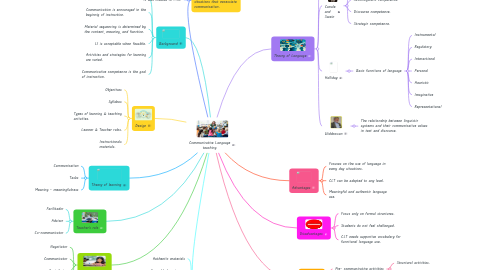Communicative Language teaching
by Jennifer Sánchez


1. It is an approach in which makes use of real life situations that necessiate communication.
1.1. It was created in 1970.
2. Background
2.1. Meaning is primary
2.2. Communication is encouraged in the beginnig of instruction.
2.3. Material sequencing is determined by the content, meaning, and function.
2.4. L1 is acceptable when feasible.
2.5. Activities and strategies for learning are varied.
2.6. Communicative competence is the goal of instruction.
3. Theory of learning
3.1. Communication
3.2. Tasks
3.3. Meaning - meaningfulness
4. Teacher's role
4.1. Facilitador
4.2. Advisor
4.3. Co-communicator
5. Student's Role
5.1. Negotiator
5.2. Communicator
5.3. Contributor
5.4. Independent learner
6. Techniques
6.1. Authentic materials
6.2. Scrambled sentences
6.3. Language game
6.4. Picture strip story
6.5. Role play
7. Design
7.1. Objectives
7.2. Syllabus
7.3. Types of learning & teaching activities.
7.4. Learner & Teacher roles.
7.5. Instructionals materials.
8. Theory of Language
8.1. Hymes
8.1.1. Whether something is formally possible
8.1.2. Whether something is appropriate
8.2. Canale and Swain
8.2.1. Grammatical competence.
8.2.2. Sociolinguistic competence.
8.2.3. Discourse competence.
8.2.4. Strategic competence.
8.3. Halliday
8.3.1. Basic functions of language
8.3.1.1. Instrumental
8.3.1.2. Regulatory
8.3.1.3. Interactional
8.3.1.4. Personal
8.3.1.5. Heuristic
8.3.1.6. Imaginative
8.3.1.7. Representational
8.4. Widdowson
8.4.1. The relationship between linguistic systems and their communicative values in text and discourse.
9. Procedure
9.1. Pre- communicative activities
9.1.1. Structural activities.
9.1.2. Quasi - communicative activities.
9.2. Communicative activities
9.2.1. Functional communication activities
9.2.2. Social interaction activities
